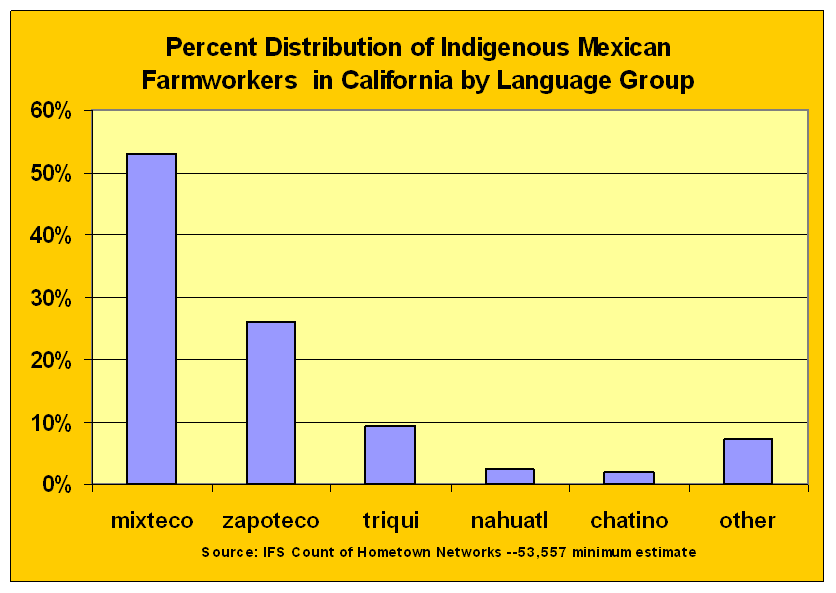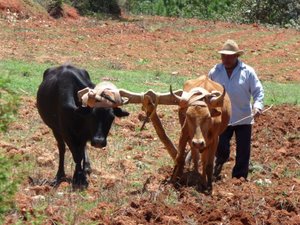Indigenous in Mexico
Main language groups
Colonial Period
Mexican Republic
The need to migrate
Migration patterns within Mexico
The Indigenous Farmworker Study shows clearly that the Mexican indigenous farmworkers who come to work in California are highly concentrated both by place of origin and by language group. The great majority come from western and southern Oaxaca where three Native American languages predominate—Mixtec, Zapotec and Triqui. In fact, eight out of ten come from the state of Oaxaca. Another ten percent come from the eastern part of the state of Guerrero, and the remaining ten percent come from other states in Mexico. Linguistically, over half are Mixtec speakers, about a quarter speak Zapotec and one in ten speaks Triqui. Only about 10% speak other languages (see the Chart below).

Before the Spanish arrived in the New World, the Mixtec, Triqui and Zapotec lived apart from the rest of Mexico. They lived in an authoritarian society in which the majority of the population was peasants who paid tribute and had work obligations to a small ruling class. In the 15th century, not long before the Spanish came, the Aztecs conquered these three peoples. The Aztecs did not disturb the local power relations but collected taxes and tribute from the elite groups who continued to dominate their ethnic kinfolk. When the Spanish colonized Oaxaca and Guerrero, conditions changed dramatically for the indigenous people of the area. The Spanish implemented economic, cultural and demographic policies that devastated not only the native people of Oaxaca and Guerrero, but the natural environment where they lived. The population, numbering in the hundreds of thousands, was ravaged by disease, abusive labor practices, and the insistence of the Spanish authorities that the people be concentrated in population centers where disease and exploitation further accelerated the demographic collapse. The Spanish brought in new economic activities that devastated the traditional economy of the region. Huge acreages were devoted to silk and cochineal dye production and to the grazing of hoofed animals. In the first hundred years after the Spanish conquest, the population may have declined by as much as 90 percent. By 1620, the population began to stabilize and slowly recover. However, it is only in recent decades that the population levels existing before the Conquest have been restored.
After 300 years under colonial rule, the Mexicans declared their independence from Spain in 1810. But the lot of the indigenous people did not improve under the new republic. Economic policies opened Mexico to capitalist development and social policies deliberately attempted to eliminate the language and identity of the indigenous peoples. Reforms often transferred communal lands to private haciendas where the indigenous either worked as low-wage laborers or fled to less fertile areas. According to official censuses, in 1808, on the eve of independence, 60% of Mexico’s population was indigenous; by 1921 that proportion had fallen to 29%. (Today it is around 6%). From the point of view of the Mexican government, the indigenous people represented backwardness and were a problem that needed to be eliminated as Mexico modernized.
The attitude of the government and the non-indigenous Mexican population in general has led to a deep-rooted discrimination against the indigenous. The indigenous have been viewed as peoples worthy only of pity and subject to derision in the popular media. At the same time that Mexicans view their pre-Columbian past with pride, the mestizo Mexicans have, at least until recently, demeaned the contemporary indigenous population. Yet it is misleading to view the indigenous as some remnant of a picturesque past, because over the last 500 years they have made important adaptations that have allowed their cultures to endure. In recent years, public attitudes in Mexico may be changing as indigenous people have asserted the right to adapt to the modern world on their own terms, harmonizing their traditions with needed reforms.
Despite aggressive efforts by Mexican society to eliminate indigenous cultures, the peoples living in the Oaxaca-Guerrero region, the place of origin of today’s California farmworkers, had by the early twentieth century carved out for themselves a self-sufficient existence. The Triquis, Zapotecos and Mixtecos produced many of the products they needed to survive, and developed a regional system to trade amongst themselves . They made their own clothes, footwear, drinks, building materials, and grew their own food. At the same time, life was undoubtedly quite harsh for the vast majority and, when the rains failed, they turned to hunting and gathering to tide them over during the bad times.

However, by the middle of the twentieth century, the regional isolation and the barter economy of the Oaxaca-Guerrero area under discussion was fast disappearing. The expansive cash economy of urban Mexico and of the larger world finally penetrated into the isolated areas inhabited by the indigenous. The time-consuming and difficult ways of producing their goods locally gradually gave way to a desire for cheaper and more convenient imported items. The old ways had their advantages and people worked in collective agreements to produce many of their necessities. But these advantages were eroded by the persistent penetration of the outside world. Outside consumer products were inexpensive and many were more durable. Imported cloth, hats and shoes soon replaced hand-made ‘manta’ cloth, palm sombreros and huaraches. Imports of Coca Cola and Tequila replaced locally made ‘tapache’ and mezcal. Plastic buckets replaced earthenware pots and manufactured tiles and corrugated tin replace thatched roofs. Furthermore, in recent years, the introduction of running water and electricity has opened up a demand for plumbing fixtures and electrical appliances of various kinds and this has also created a need for cash.
In addition to the need to purchase consumer goods, building materials and farm inputs, the eroded terrain has not been able to keep up with the food demands of an expanding population, let alone generate a cash surplus. The introduction of chemical fertilizers, pesticides and pumps in order to increase production have had unintended consequences in these environmentally marginal environments. The introduction of gasoline-powered water pumps, while increasing yields, has failed to raise incomes for local producers since intermediaries, mostly city people, who sell the pumps and fuel, and market the commercial commodities, capture most of the extra value produced. In the meantime, because land and water are allocated to export crops, less of the staple crops destined for local consumption are produced. The integration of the Oaxaca-Guerrero area into the larger cash economy meant that to survive, local people had to seek cash-paying jobs in order to pay for both the imported consumer goods and to cover the shortfall in food production.
Migration patterns within Mexico:
When the indigenous first felt the need to migrate to survive, they initially migrated, in large measure, to other parts of Mexico and on a temporary basis. Many studies have documented these movements. The work-history interviews we conducted in the Indigenous Farmworker Study confirmed these earlier reports. The earliest indigenous migrants to California came from the towns near the major roads in Oaxaca; only later did people from the more remote towns join the migrant stream.. In the 1940s, the indigenous were migrating seasonally to Veracruz to cut sugar cane and pineapples. Then, in the 1960s they began to go to the nearby state of Morelos to work in the vegetable harvest. In part due to labor recruitment campaigns by employers, the indigenous subsequently undertook the long distance trek further north, to Sinaloa and Sonora to work on vegetables and cotton. Finally in the 1970s, they crossed over the Sea of Cortez to work in the vegetable and later the strawberry industry in Baja California. The most important temporary work destination over the years according to our study was Sinaloa.
In addition to reporting their various work destinations, respondents also told us about the places where their communities formed settlements in Mexico. Migrants from Oaxaca and Guerrero established long-term settlements in agricultural work areas such as Sinaloa, Sonora and Veracruz, while many others settled in the state of Mexico and in Mexico City. However, by far the most common place to settle—over half of the settlements reported in our study—was Baja California.